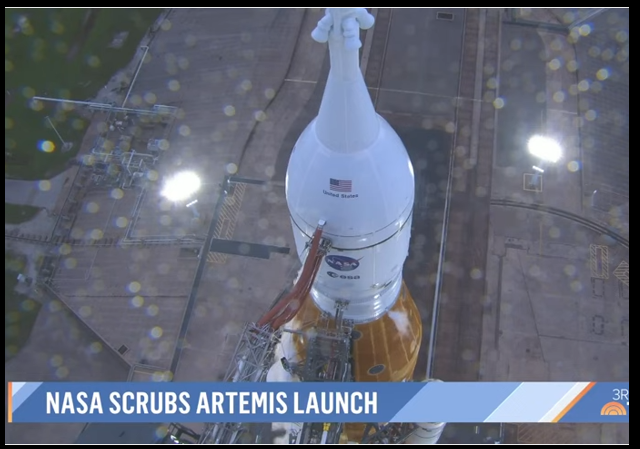Launch of NASA’s Artemis I-Space Launch System Delayed For Weeks
NASA will attempt to repair SLS liquid hydrogen leak on the pad.

Officials at the National Aeronautics and Space Administration (NASA) indicate that the first launch of the Artemis I – Space Launch System (SLS) has been postponed for weeks after another dangerous fuel leak forced launch controllers to call off their second attempt.
The previous attempt at launching the 322-foot Space Launch System rocket, the most powerful built by Nasa, was also troubled by hydrogen leaks, though they were smaller. That was on top of leaks detected during countdown drills earlier in the year.
After the latest setback, mission managers decided to haul the rocket off the pad and into the hangar for further repairs and system updates. Some of the work and testing may be performed at the pad before the rocket is moved.
Either way, several weeks of work will be needed, according to officials.
With a two-week launch blackout period looming in just a few days, the rocket is now grounded until late September or October. Nasa will work around a high-priority SpaceX astronaut flight to the International Space Station scheduled for early October.
NASA’s team will attempt to fix on the pad a liquid hydrogen seal that caused the launch scrub.
NASA said that technicians will proceed with plans to replace the seal for the interface called the quick disconnect between a liquid hydrogen feed line and the core stage of the SLS. That work will be done on the pad rather than rolling the vehicle back to the Vehicle Assembly Building (VAB) at the Kennedy Space Center.
A problem with that seal resulted in what officials called a large leak of liquid hydrogen during fueling of the core stage during the Sept. 3 launch attempt. Several efforts to reseat the quick disconnect, by warming and then cooling it and by applying helium gas pressure on the fitting, failed to stop the leak, and NASA called off the Artemis 1 launch attempt three hours before the two-hour launch window opened.
…One advantage of doing the work at the pad is that workers can then test the fitting using liquid hydrogen there, which is not an option if the work is done back at the VAB. “That is the only place we can get a full cryo test and be sure we do not have a further issue with respect to leaks at the temperatures we need to fill the vehicle on the day of launch,” [Mike Sarafin, Artemis mission manager] said.
Despite this launch setback, NASA is still proceeding with the current schedule for the Artemis II and III missions.
Once this rocket successfully lifts off, it will send a crew capsule called Orion on a journey to orbit the moon, coming within about 60 miles of the lunar surface. After more than five weeks, it will return home and splash down in the Pacific Ocean.
The next flight of this rocket will carry people, but it isn’t scheduled until 2024. The agency is targeting a 2025 moon landing — although most space watchers expect delays, as this rocket is already years behind its original schedule. Congress had wanted it to fly in 2016, just five years after NASA retired its aging fleet of space shuttles.
Nelson said on Saturday that despite the most recent Artemis 1 delays, NASA was still planning to launch Artemis 2 in 2024 and Artemis 3 in 2025.
 DONATE
DONATE
Donations tax deductible
to the full extent allowed by law.









Comments
“Artemis delayed for weeks”
That means manned flights to the moon delayed for years.
And years.
That means manned Artemis flights to the moon will be delayed for years. I would not bet that SpaceX won’t beat them.
Subotai Bahadur
The Artemis program is an over budget, behind schedule joke.
Another sign that at both local and national levels the people in charge lack competency. Everyone is now skilled at politics but not at actually running anything. Much like the great HBO series Chernobyl where the guy who runs the facility used to run a shoe factory. We will all be poorer for it.
Well said. No competency, no drive, nothing but PC fear an pronouns. We are a society in quick, quick decline.
Get spacex involved
Since NASA refuses to let anyone around them. Here comes China.
Obviously this could have been prevented if they had more BIPOCs on the design and construction teams
“NASA will attempt to repair SLS liquid hydrogen leak on the pad.”
“Um… is it too late to change my ticket?”
Maybe if they resurrected Kubrick, it would help?
How many H1B engineers?
How many Chinese parts?
I dunno. But on the plus side, there is a small metal plate that reads, “Assembled in America”
More incompetence from the government.
And no one fired. Again.
It will never fly. This is, by design, simply a means to keep milking the taxpayers for money to be channeled to cronies in the aerospace industry for “repairs” or “changes.”
It will never fly.
It sounds like Gary Seven did his work well. 😉
Doesn’t current SpaceX run on hydrogen? Maybe they could ask Elon’s folks for a hand fixing this.